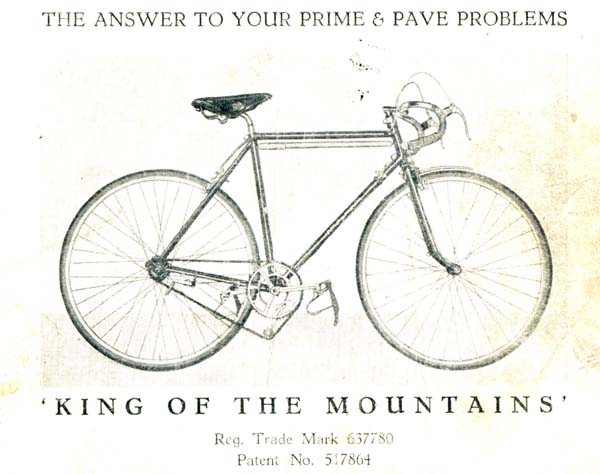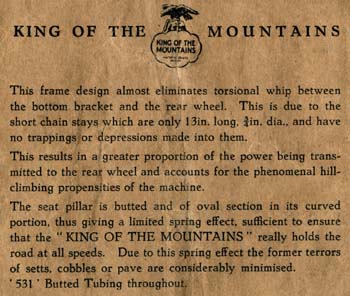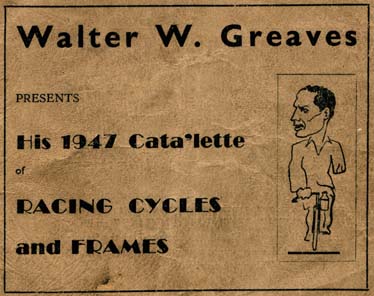Greaves, Walter
Posted: Tuesday 02nd June 2020
Walter’s obvious physical disability was that his left arm finished at the elbow. That didn’t stop him from brazing, filing, spray-painting, wheel building, repairing bikes and prams, or cycling. His claim to fame was that in the 1930’s he had established a world record for the highest mileage ridden in a year. This was as a pro for Three Spires Cycles, presumably of Lichfield. Establishing this in a British twelve-month, with an illness in February, was no match for Hubert Opperman’s subsequent ride in sunny Australia. (See report at end of page.)
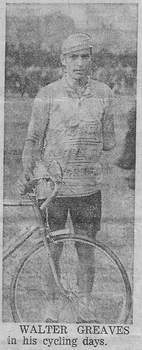
The machine Walter used when I knew him had a straight handlebar on the left side with a sponge-filled cup, both brakes going to a single lever on the right. He must have also had a gear lever up high, at a time when all were on the down tube, but that is one of the things I have forgotten.
Walter Greaves was an intelligent man of good facial features and strong opinions, firmly expressed, but without swearing. Unfortunately, he was born with an anti-establishment gene, which meant that he had fallen out successively with the various Bradford cycling clubs, and the cycling authorities in general. His two strongest opinions were about drink (dead against) and Communism (for). He saw himself as representing the proletariat who would gratefully rally behind him. After I got to know him well he divulged that he had lost his arm after an incident involving a door and his drunkard of a market stallholder father (see comments by Ken Russell below).
His Shop
This stood at a busy crossroads, on the corner of Toller Lane, where I lived, and Whetley Lane, which led directly down to Whitaker & Mapplebeck’s half a mile or so away. Everybody knew the shop because it was on the busy trolley-bus route up to the Infirmary, and had outside a large swinging sign of Walter in profile looking out at the traffic as he rode towards you or away, depending on how you approached. It was no usual cycle showroom, there being no capital to tie up in stock. The most likely things to be found would be somebody’s pram or a local ‘grid’ to be kept going a bit longer. There weren’t too many of those either, thanks to the Bradford hills, the awful cobbles, and the fast smooth trolley buses.
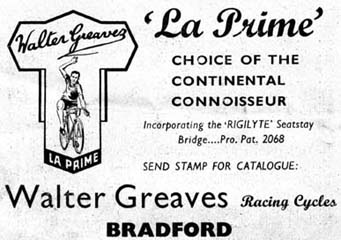
Walter and Renee lived ‘over the shop’, or rather over several and kept a pet monkey, so that the air upstairs was never quite fresh. Mrs G was tiny and would nowadays be described as ‘feisty’. She was the first person I heard use the term ‘Buggerlugs’. (To him, not me). Out of sight in the cellar was the frame-building shop, usually quiet, as orders were very spasmodic. There was little money for advertising so most frames were re-orders, or the result of having been seen out on the road. The centre-piece of the workshop was the really impressive pivoted frame jig built from welded U-section girder, supported by tube mitreing machinery, paint spray and an enamelling stove. As the shop was near my home I spent many hours there, and my clubmates got absolutely fed up with ‘Walter Greaves says…’
My first ‘real’ bike
Naturally this schoolboy was guided to the unconventional ‘King of the Mountains’ (see image and details below), of which WWG was very proud. It achieved its objective by having a steep seat tube and short top tube, then cantilevering the rider out over the back wheel on a steel seat tube bent to the horizontal! Whether it did improve one’s climbing I know not, as I was still rubbish on hills, but it did give me problems mounting a saddlebag, I had to make a Meccano frame. Also being a shy ‘tuggo’ I didn’t like being the object of curiosity. I asked for a ‘maroon’ frame with gold box lining. ‘Let’s call it cerise, it sounds better’. The finished machine had a single freewheel, steel chainset and pedals, steel stem, narrow steel rims, Dunlop ‘Road Racing’ tyres, a Brooks B17 or B15, steel brake levers and ‘Binda’ bends. I read later that Henri Binda made it a point of honour never to rise from the saddle ! The bill came not to the £14 quoted but to £20. My father, who ran a factory very firmly, was not amused, I wasn’t present at the subsequent interview. Later, when I wanted a ‘3-speed’ Walter fitted me up with one of his own, a single-roller ‘Simplex’. My own derailleur! Sturmeys were for ‘chip-holers’. (Posers who rode round and round the town centre ending up at the chippie -Ed)
The frames
There were two designs available, the patented ‘King of the Mountains’, which had round forks, and the conventional ‘La Victoire’ with oval. Both had a solid brake-mounting bush in the rear bridge, Walter being dismissive of a transverse hole through the tube. The ‘KoM’ was Walter’s attempt to achieve the rigid back end and short chainstays sought by such as the Baines ‘Gate’, twin-tube Saxons, and the like, which all aimed to put the rider’s weight over the back wheel. Both types of frame were 531 ‘welded’ i.e. lugless. To watch this one-armed man mitreing and brazing, then eventually box lining by trailing a slim strip of paint-soaked paper filled me with admiration.
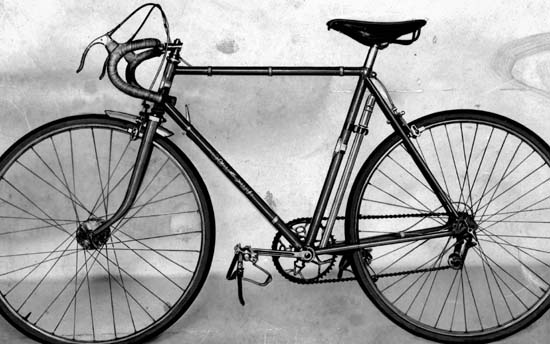
The downtube transfers were, I think, a Times New Roman style in solid gold letters, with either ‘Walter’ or ‘WW’ small then ‘GREAVES’ large. Almost certainly ‘Walter’. The head and seat tube transfers escape me altogether, although I associate ‘La Victoire’ with an oval. Pathetic, when I’ve seen them times without number. When I went to order a new frame Walter was displeased that I wished to go conventional, but instantly realised on which side his bread was buttered. I can’t even remember how it looked, but it was a Paris-style paint job using three colours. I do remember that my brother’s ‘La Victoire’ was done the same way; a beautiful metallic turquoise frame with a silver ‘splodge’ then a flamboyant red one in the centre. How silly that I can’t remember what my own looked like, or what became of it. I do remember that it was darned good, did a load of miles, had Stallard rear drop-outs with the long guide spikes, and a hanger for my Osgear – but no beautiful lugs.
Once I had a bike and started knocking around a bit I found that half a dozen of the local lads were wont to go off cycling together from time to time, so I fell in with them and we formed a regular group. I recall that we could raise a Hobbs of Barbican, a WF Holdsworth with solid large-flange hubs and a Baines ‘Gate’ . Never to us a ‘Flying Gate’. The others are forgotten.
Walter Greaves saw this group as a heaven-sent opportunity. Having fallen out with all the local clubs, here was his chance to form his own and do things his way.
We were all agreed on affiliation to the colourful BLRC, but what to call this club? The Olympic spirit was Walter’s sporting ideal, and he insisted that Olympic should be in the title. How about ‘Bradford Olympic’, the obvious choice? As there were already East Bradford, West Bradford and Bradford Elite (all NCU), Bradford Co-op Velo and the other League club Bradford RCC, together with the minuscule non-racing North Bradford, Greaves pushed for ‘Airedale’, so Airedale Olympic was born, with me as its first Secretary.
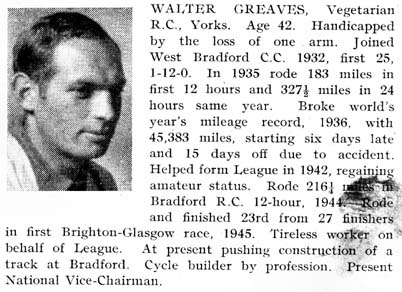
Later came South Bradford and Star, both BLRC clubs, and then the Bradford Elite turned ‘League’ to great rejoicing amongst the ‘Leaguers’ and to the dismay of the ‘Union’. Star was an ‘exclusive’ peel-off from Bradford RCC. We sought to register as our colours yellow with a black chest band, but Polhill RC already had that, so we made do with yellow with black collar and armbands. None of the NCU before-breakfast black for the BLRC.
In the course of time we gathered new members, including about four from the Farsley area between Bradford and Leeds, and one of these relieved me of the ‘King of the Mountains’ which had so stupidly embarrassed me. After my time the axis of the club swung towards Leeds, which really is in Airedale. It’s still going, and long may it do so.
Walter’s dream was to open a cyclists’ cafe at a certain bungalow on the Keighley road south of Skipton. Cyclists would flock to it – except that they wouldn’t, Walter wasn’t half as popular as he imagined. As far as I know he did go to live on that road and became a folk singer, claiming, being Walter, to be the definitive voice of Yorkshire Folk, and living into his eighties. Someone who was there then will no doubt have the right story.
Ian Peacock on Walter:
In his folk singing incarnation, Walter wrote a great song about the granting of the old age pension, entitled “What Lloyd George Gave Me”. The chorus goes:
He took me out of t’workhouse,
And he gave me life that’s free,
Five shilling a week for cheatin’ death,
That’s what Lloyd George gave me.
A North Yorkshire trio called “Castabella” can be heard giving an authentic rendition to this day.
“Walter bought the premises we knew as “Winifred’s Cafe” on the Skipton road, intending to reopen it as a cafe and to use the garage as a Forge. As there was no mains water, he tried to drill a water bore hole and he did indeed locate water but it turned out to be water from the canal !!!..
The cafe project was dropped but the Forge was a success. When Walter became ill with Parkinsons disease, his son took over the business. I called to see Walter around 1986. He was living in terrible conditions but still talking in a positive way about obtaining a word processor and writing his autobiography.
Whilst I was there he told me how he lost his arm. Apparently his father was a Quack doctor and an alcoholic. Whilst travelling in his father’s car round the bend at Sandbeds, Idle, (approx. 200 yds from my place of birth), his father was the worse for drink. Walter decided to “bale out” on to the running board at the same time as they passed a tram. The tram hit his arm, which had to be amputated below the elbow. After his death,the premises were sold and then demolished. The new owner built a stone detached house of very modern design on the site and named it “THE FORGE”.
I do believe that Walter teamed up with Geoff Wood (Pennine Cycles) for his folk singing. I seem to remember seeing them both on TV from a club on Kirkstall Road in Leeds back in the 70’s”
Walter’s world record – an extract from Bradford Telegraph and Argus 18 April 1978 Bradford cyclist Walter Greaves lived with his mother in Newlands Place Undercliffe, when he set out on January 6, 1936 to attack the world record of 43,996 miles cycled in a year. He quickly met a lot of bad winter weather. On the first day he rode against the wind to York and for four of the first seven days he was soaked by rain. Travelling to Doncaster he finished with ears and fingers frostbitten. He completed a Leeds-York-Beverley-Selby circuit in driving snow and on roads glassy with ice. One day, struggling through snowdrifts on the North Yorkshire moors, he fell off his machine eight times. Soon he was going further afield and finding better weather and by mid-June he had completed 21,500 miles. He rode a lap of honour at a track meeting at Herne Hill.
Greaves, who had lost his arm in an accident as a teenager, had a specially constructed one-handlebar machine, and as a vegetarian kept to a diet of milk, brown bread, butter, tomatoes, apples, nuts and orange juice.
He was in line for 50,000 miles in the year when an abscess formed on his leg after a spill and necessitated a minor operation which cost him a precious fortnight. In November he was introduced to the Duke of Kent at the Bicycle and Motor Show at Olympia.
He broke the record on December 13 and did a lap of honour at Hyde Park followed by hundreds of other cyclists. The Western Brothers then presented him with a trophy from the makers of his machine (Three Spires Cycles). He said that his biggest mileage in one day had been 262 but that he went 374 miles at a stretch over two days without sleep.
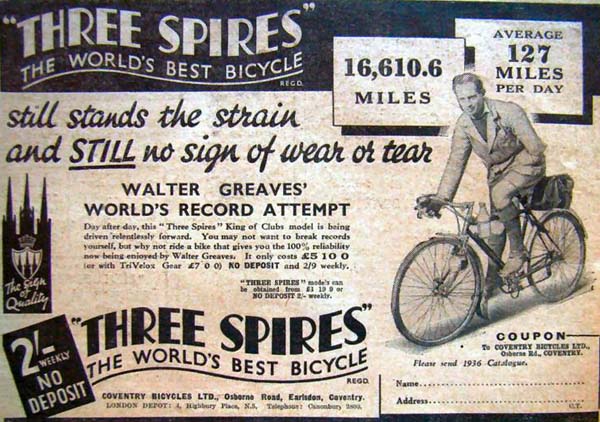
I worked with a lot of communist or former communist party members, some were ex-Spartacus CC, the former communist cycling club. A lot of these chaps were also Vegetarian CC. He also provided a link to more fascinating details of Walter Greaves’s life at http://www.cyclingnews.com/features/?id=2006/woodland_greaves
Andrew J. Eatch ex-East Bradford CC (and son of Jack Eatch, Bradford Co-op Velo).
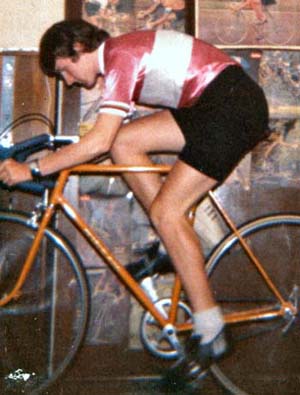
I’ve been viewing your site with great interest. Although my cycling days were in the ’70s, my father had been active in the BLRC in the late ‘40s and through him I got to hear about Geoff Wood, Ken Russell, Walter Greaves, Billy Dodds, Geoff Clark and other Bradford riders. Bill Dodds was best man when my parents were married. I must point out that the quote from Michael Butler at the bottom of the Walter Greaves bio page is wrong, unless there is a Three Spires bike on display in Bradford Industrial Museum. I haven’t seen it, but I have seen my ‘old friend’ there many times! It used to be my bike, well, the frame was.The true story of the Greaves ‘King of the Mountains’ in Bradford Industrial Museum.
The Greaves ‘King of the Mountains’ in the Bradford Industrial Museum was not Walter’s record bike.
It was mine! I’m prompted to write this because I’ve recently seen a few incorrect statements on the web. The frame in question was built around 1948. My father owned this Greaves ‘King of the Mountains’ and kept it after he gave up cycling. It stood in our garage as a complete bike with an Osgear, and cobwebs all over it, when I was a child. It was predominantly green, with a sort of rainbow effect overspray paint job. Round about 1970, Dad took the ’King of the Mountains’ frame back to Walter, thinking that he might like to have it. Dad knew Walter from the League days and had kept in touch, albeit infrequently.
When I became keen on cycling, around 1974, Dad took me out to The Forge, near Skipton, to see Walter, who gave us a performance of folk singing, accompanying himself with a small ‘squeeze box’ concertina. He used his shoulder and his one hand to play it. My other strong memory of that visit was the torrent of the most shocking and crude swear words which emerged from his mouth when, for some reason, the Royal Family was mentioned. It states on your site that Walter was not one for strong language, but he certainly excelled himself on that occasion. We ended up bringing the frame back with us: Walter had no interest in it. He also gave us a full set of the correct transfers.
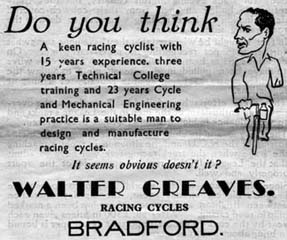
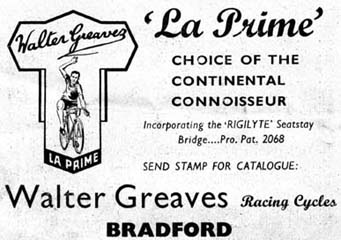
My father got really keen about it on the drive home and instead of going to our house Dad drove straight to Geoff Clark’s cycle shop at Horton Grange in Bradford. It was left there for shot blasting and a re-spray – ‘Spanish Orange’ was the colour chosen. The transfers were to be fitted, the seat pin re-chromed and a new headset fitted. I built the bike up with current equipment – a single Campag chain-ring with a close ratio 5 block, a Shimano mech and a Unica saddle. I did use a pair of Chater Lea pedals, so there was a hint of original equipment there. There was some difficulty in fitting the rear derailleur because the ‘horned’ part of the dropouts (I think Stallard) interfered with it and we sawed them off at both sides, so that they matched.
I rode the bike in time trials, and later used it as a winter bike, with fixed gear and a French dynamo fitted under the bottom bracket. The seat pin was always a sloppy fit and occasionally came loose. This was nothing to do with its unusual shape, but it was thinner than it should have been because of excessive bead-blasting before being chromed – it had been very rusty. Of course, I couldn’t fit a normal seat pin… The ‘King of the Mountains’ was a good bike to ride and compared well with my main bikes, a Favori and a Pennine. It always attracted a lot of attention, and requests from other club members to ‘have a go on it’.
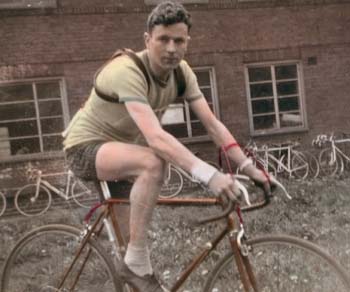
I gave up cycling (for the first time) in 1977 and the frame was sold. I was astonished some years later to see it in the Bradford Industrial Museum, presumably donated by the man who had bought it from me. It had been built up with equipment fairly correct for when the frame was built, but with fixed gear and a front brake only. These frames were intended for use road racing use and would have probably had four or five gears, with most likely an Osgear mechanism or similar. There the bike still stands, getting progressively more neglected as each year goes by. The placard in front of it states that ‘little is known about this bicycle’, despite the fact that I sent the museum a lot of information about it many years ago. You can still see where I chopped off the dropout horns, and where my dynamo and cable clips have left scratches on the now faded paintwork. I must contact the museum again and hope that they will take some action over this unusual bit of cycling history. I note that there is a Wikipedia entry now for Walter Greaves that doesn’t mention his frames or this unorthodox design but has managed to get it wrong about ’my’ bike. I hope that this is of interest to you.
Posted: Tuesday 02nd June 2020
Contents
- Walter Greaves
- His Shop
- Buggerlugs
- Walter Greaves La Victoire
- Downtube Transfers
- Walter’s club
- Record Breaker
- Walter’s Dream
- Ian Peacock on Walter
- Ken Russell's
- Walter’s World Record
- Duke of Kent
- Three Spires Cycles
- Three Spires Bicycle
- Michael Butler
- King of the Mountains Bicycle
- Greaves ‘King of the Mountains’
- Walter Greaves Images
- Geoff Clark’s Cycle Shop
- Walter Greaves photos
- More Greaves
This article appears in the following categories.
Upcoming Events
Whether you are looking for a gentle social meet up, or a 100-mile ride browse the community’s upcoming events and plan your next weekend outing.

